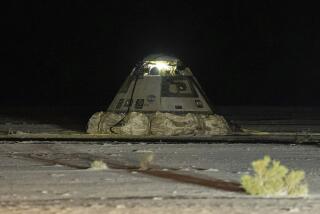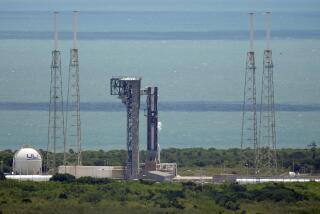Trouble-Plagued Shuttle Lands Safely at Night
EDWARDS AIR FORCE BASE — Descending from a clear, starlit desert night sky, the space shuttle Columbia landed safely here late Monday, ending a nine-day mission marked by technical glitches and scientific advances.
The shuttle touched down at 9:54 p.m. before a crowd of just more than 500 who braved 37-degree temperatures. “Houston, wheels are stopped at Edwards. We’re home,” said Vance D. Brand, commander of the Columbia.
“Roger that, Columbia. Welcome home. Beautiful landing. Outstanding job,” said astronaut Mike Baker from the Johnson Space Center in Houston.
An approaching cold front bringing threatening weather forced NASA officials to cut the mission short by one day. The night landing, which ends the 38th shuttle mission and the 10th flight for Columbia, was the fourth in shuttle history.
The launch of the shuttle was plagued by delays and the mission hampered by technical problems, but nevertheless yielded significant astronomical data.
Shortly after the launch, both computers that were to point the four telescopes that study ultraviolet light and X-rays and lock them on their targets failed to work. The crew later found that lint clogging the air vents caused both computers to overheat.
The astronauts overcame the potentially mission-threatening glitch by working with technicians at Mission Control at the Marshall Space Flight Center in Huntsville, Ala., who radioed commands to point the telescopes in the general direction of their targets. Then the astronomers, working with a joystick similar to those used on video games, aimed the telescopes and locked them on target.
Later, National Aeronautics and Space Administration officials thought they would have to cut the flight short by one day because the drain tube for the waste disposal system jammed. The crew had to pump the waste water into plastic bags, restoring the system to working capacity.
NASA spokesman Don Haley acknowledged that “as far as problems that were visible,” this mission was probably the most trouble-plagued flight other than the Challenger explosion.
Despite the difficulties, NASA officials are elated at the volume of data the telescopes have yielded. “They collected more science than scientists and astronomers can assimilate,” Haley said.
The Astro Observatory aboard the Columbia contains four telescopes that can detect X-rays and ultraviolet light that are obscured by the Earth’s atmosphere. They provided scientists with valuable data on various planets, stars and galaxies.
Two of the telescopes also provided unprecedented evidence that indicates the existence of black holes.
Monday night, scientists reflected on their roller-coaster nine days at Marshall Space Flight Center. “For the scientists, we’re just beginning” to study all the exciting data collected, said mission scientist Theodore Gull, who said he “broke down” after the emotional conclusion of science activity. “We know we are going to help rewrite the textbooks.”
Despite the telescope-pointing problems, which meant only 135 of 250 planned observations were made, the science part of the mission ended on the upswing, with the astronauts targeting a fast-moving comet just minutes before the three ultraviolet instruments were shut down.
The workhorse Broad Band X-ray Telescope--built at Goddard Space Flight Center and pointed independent of the Astro crew from a control room at the Greenbelt, Md., center--operated for several more hours, taking a final look at a distant galaxy.
“We went out with a bang,” said Arthur Davidsen, who heads the team that built the Hopkins Ultraviolet Telescope at Johns Hopkins University.
Brand, 58, completed his fourth shuttle mission. Other crew members are pilot Guy S. Gardner, mission specialists Jeffrey A. Hoffman, John M. Lounge, Robert A. R. Parker, and payload specialists and civilian astronomers Samuel T. Durrance and Ronald A. Parise.
More to Read
Sign up for Essential California
The most important California stories and recommendations in your inbox every morning.
You may occasionally receive promotional content from the Los Angeles Times.










